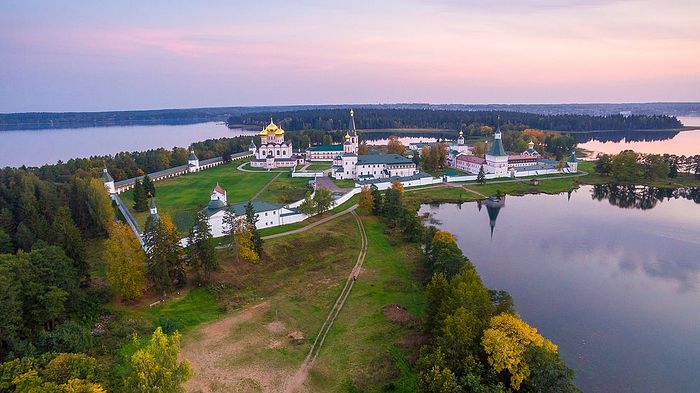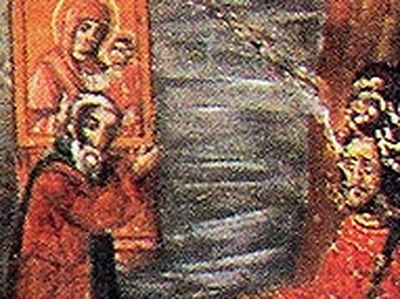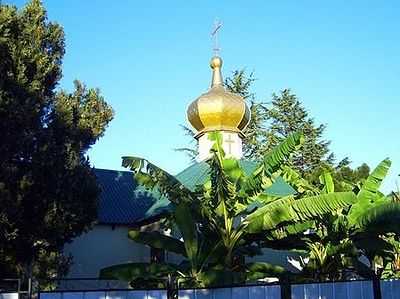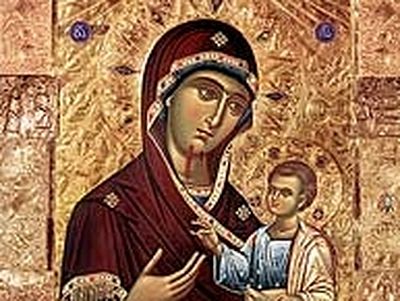On February 12/25, the holy Orthodox Church commemorates the apperance of the Iveron Icon of the Mother of God on Mt. Athos which is one of the most beloved miraculous icons in all of Orthodoxy. There have been several miraculous copies as well, including the Valdai Iveron Icon in Russia. The story of that icon and the monastery where it was housed is presented here.
Let’s begin from the very beginning. After the Ascension of the Lord into heaven, the Apostles began to prepare to preach the Gospel in various countries. To figure out who would inherit which country, they cast lots. The Mother of God also asked where to go. To her fell the Iberian lands, but an angel notified her that she was destined to serve the Lord in another land. And so it happened.
A wind blew the ship upon which the Mother of God was sailing towards Mt. Athos. I must say that the whole mountain was filled with idols and a shrine to the god Apollo was there, and many pagans came there to worship. When the Mother of God set foot upon the land, all the idols cried out for the people to go to meet the mother of the true God, Jesus. All there fell upon their faces before the Theotokos, believed in the Lord, and were baptized. And the Mother of God, having worked numerous miracles, blessed this place, promising her patronage until the end of the age. Emperor Constantine erected three great monasteries on Mt. Athos (now there are many more) and settled monks in them, and he ordered the mountain to be called “Holy.”
Once a valiant commander of the Iberian Tornike kingdom came to Athos to the simple monks. In those days the Persian hosts were taking up arms against the imperial city, and there were none to be found who could oppose them. Then the queen asked Tornike to come, and he, having slaughtered the barbarian hordes, returned with great victory. The queen offered him as victor much gold, but he entreated her to use the money to establish a monastery to be a refuge for the Iberian people. She promised to build such a monastery that nothing more beautiful would be found upon the earth. And that is what the Lord had destined for it.
In the ninth century there was a persecution of the holy icons. A widow of the city of Nicea guarded the icon of the Mother of God. Having learned about it, soldiers-iconodules appeared and began to demand money for the icon, threatening to burn it, and in anger pierced the icon with a lance. And—oh the horror!—blood appeared on the cheek of the Theotokos as from a living wound. Saving the image of the Mother of God, the widow carried it to the sea, and the icon, standing upon the water, departed from her. It appeared in a pillar fire many years later (in 999) by the walls of the Iveron Monastery, desiring to be on its gate, from which it is called “Portaitissa” (“Keeper of the Gate”). A multitude of miracles have been performed by the icon, even until today. There are many copies of the Athonite Portaitissa the world over, including many which are also miraculous. Word of the Iveron Icon spread throughout Russia through pilgrims, and the future Patriarch Nikon ordered a copy. From here begins the history of the Lake Valdai Iveron Mother of God Monastery. But—all in due time.
While yet Metropolitan of Novgorod, Nikon often went to Moscow, traveling through Valdai to get there. The Valdai Hills are the highest point in European Russia and very picturesque. A special beauty distinguishes Valdai Lake (and now, habitable and populated, it is magnificent, but it used to be a wondrous wilderness, shining with transparent and deep crystal clear waters, covered by green islands with narrow channels, and decorated with picturesque carved shores with sparse villages). Having taken note of such beauty, and questioning the residents in detail even about the fishing there, Nikon decided that such a place was worthy of a monastery. Longing for the place of his last igumenate before departing for Moscow, the faraway Kozheozersky Theophany Monastery, another spiritual gem of the Orthodox Russian north where his spiritual father the elder Bogolep (Lvov) remained, clearly affected the future patriarch.
Then, without hesitation, Nikon appealed to Tsar Alexei Mikhailovich, and as if notified by God, he joyfully endorsed the idea of the monastery, promising it his patronage. During his trip to Solovki for the relics of the Moscow hierarch Philip, Nikon was deemed worthy of a vision of this ascetic, who also approved his intention. And when Nikon became patriarch, he realized his longstanding dream. Even earlier, as an archimandrite, he heard much about the miracles of the Iveron Icon on Mt. Athos. When an Iveron archimandrite happened to be in Moscow, Nikon asked for a copy of the miraculous icon to be sent to Moscow with the layout of the monastery itself.
The icon arrived in 1648 together with a letter from the whole Iveron brotherhood, in which was described how they created the future sacred object. All the brethren, after long prayers, doused the miraculous icon with holy water, then added the relics of some saints and paint to the water, and painted the icon with it. The iconographer took food only on Saturday and Sunday, and the brothers remained in prayer. They reported that the icon appeared the same as the one on Athos, only newer. Obtaining the icon, Nikon started creating the monastery, taking the Iveron Monastery as a model and giving it the same name. The building of the monastery churches and buildings began in 1653 under the supervision of the patriarch and the very active support of the tsar and dignitaries. The patriarch himself consecrated the new abode and placed within it the richly-decorated Iveron Icon and for the spiritual support of the brethren ordered that the relics of St. James Borovichi be transferred there, and also pieces of the relics of the Moscow hierarchs Peter, Alexei, Jonah and Philip, which was performed to the ringing of the bells. A great miracle appeared—a pillar of fire, from which came a brilliant light. God had blessed the monastery. Then Nikon blessed Valdai Lake, plunging a Gospel and cross to the bottom of it and renaming it “Holy.” So was born the monastery. During Nikon’s patriarchate Valdai Monastery was placed under his patronage and prospered, but with the imprisonment of the patriarch the wellbeing of the monastery fell. Imperial favor ceased, patrimony was gradually selected, and great calamities brought fires, and only the intercession of the Most Holy, and the vigorous effort of the abbot saved the Iveron Icon.
As other monasteries, it did not escape a sorrowful lot after the revolution. Many monastery buildings, utensils, and the main sacred object—the Iveron Icon of the Mother of God in a golden frame, did not survive. The monastery was again returned to the Church only in 1991. A Moleben was served before one of the copies of the Iveron Icon preserved in the Valdai church, and monastic life began: prayer, labor, and festivity. The memory of the Iveron Icon is especially honored in Valdai, celebrated as on Athos, on Bright Tuesday, Annunciation, Dormition, the day of St. James Borovichi, and the main monastery feast in honor of the Iveron Icon (when Valdai was saved from a plague) on August 10. On this day the monastery is filled with worshipers, the monastery hotels are full of pilgrims, and there isn’t even enough room for everyone to sleep on the floor.
The festive Liturgy begins in the morning in the summer church of the Dormition of the Mother of God. “The Iveron Mother” is decorated with monastery flowers grown in flowerbeds, and expensive flowers bought especially for this great day, and simple field flowers brought by children. The service is as if in Heaven, and the priestly vestments and coverings are all of a wondrous light blue, for the Theotokos. There is no iconostasis; the entire church is an altar, God’s dwelling place. Worshipers have come to the church in advance, to the great Dormition Cathedral, but there is not enough room for all the people who want to have a closer look at the hierarchs, the abbot, and all the clergy from the Moscow region, Borovichi, Novgorod, and the Leningrad region who are visiting for the feast of the holy monastery. The Moscow choir directing school of Kustovskii comes to sing. After Liturgy there is the traditional cross procession, usually blessed by rain, and then immediate bright sunshine. They carry the Iveron Icon in front, all sing the troparion together, congratulate one another, then all pass under the icon which two priests are holding. You enter into the church and feel as if the Mother of God has caressed your head. Then there is a festive homily in the church, and afterwards a meal for all, delicious and ample, and how could it be otherwise—after all, we are feasting on the day of the Mother of God. Rather sated, you begin to speak with pilgrims. Who are you? Where are you from? How did God lead you here? It turns out most are from St. Petersburg and Novgorod, and there’s Muscovites too.
People come not just to Our Lady, but also to her pupils—the fathers who have learned to live virtuous lives. All the monks and novice and even pilgrims at Valdai are a family. You arrive as a relative, and how hard it is to leave relatives—some even weep fervently. But they know they will certainly return. Anyone who has been to Valdai at least once is drawn back and returns. In all the brotherhood is no more than twenty, all from various places, and differing in character—where does such a unity come from? They say, perhaps, because they are happy and welcoming, with Divine joy.
Fr. Boris jokes, laughing at pilgrims; they say it humbles them and they take no offense at all. The children ask to play among the pebbles and he plays with them. He also serves in the surrounding villages for his “beloved grandmas.” He bakes prosphora and the most delicious bread; the newspaper even asked for the recipe, but he didn’t give it to them.
Fr. Nikandr is the dean, and the housekeeping of the whole monastery and the church is on him. He takes great care for the cleanliness in the church, and the pilgrims know that if he asks them to clean the church, it means they have earned his position.
Fr. Anthony is very focused; he is always at the services. Many have much to say about this batiushka—it’s one of the pilgrims’ favorite topics of conversation.
Archimandrite Ephraim (Barbinyarga) manages everything. The monastery is being reborn by his labors, undergoing restoration and repairs. He is Moldovan, and the choir decided to give him a gift on Pascha, singing “Christ is Risen” in Moldovan. A bus full of Romanian Orthodox had arrived, and how they rejoiced to hear the Paschal greeting in their native tongue. It was as if they had found family, and they left so happy.
This is Valdai. Everyone has their own favorite part: the kids love the lake where it’s so nice to swim, artists and photographers love the amazing scenery, archaeologists have something to dig, historians have something to study, and simple worshipers come to help as their strength allows, and to pray. All are welcome and already love the place.





